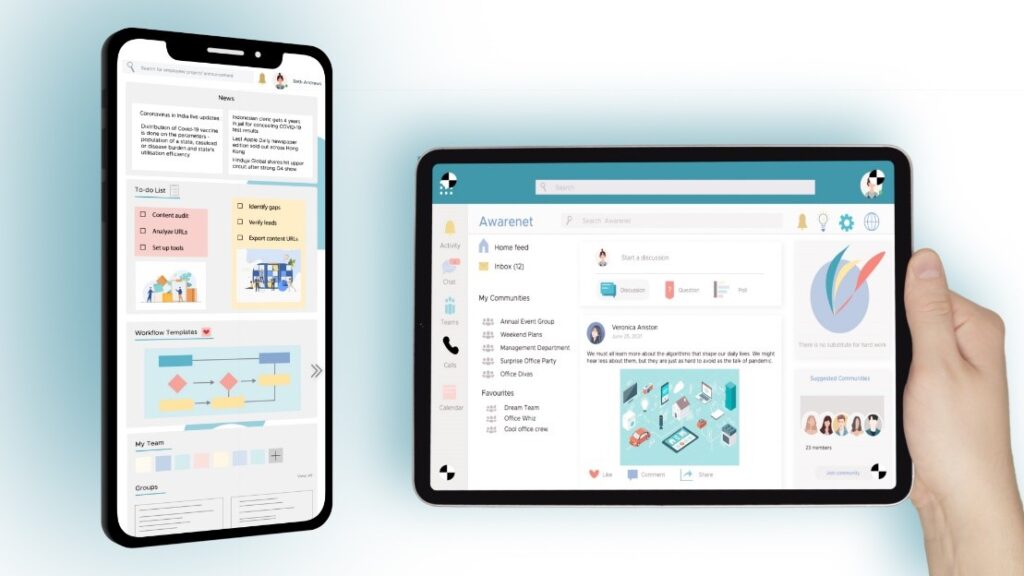Ensuring that the workforce is informed and connected is the key to the success of all business initiatives and goals.
Learn how the Digital Workplace is bringing it all together.

There’s a reason why the digital workplace has been in talks lately.
Analysts forecast that companies will spend nearly $35–80 billion on digital workplace technologies in the next few years. From our research, we know that 73% of organizations plan to increase spending specifically on workforce communication, engagement, and productivity.
Digitization is not just a challenge for HR and IT to sort out in the next few years—it will require the entire company to adapt and shift.
What is the Digital Workplace?
With so many newer concepts coming up, nailing down a single definition for the “digital workplace” can be difficult; however, one of the first and simplest may also be the most accurate:
The digital workplace is the “virtual, digital equivalent of the physical workplace & eco-system.”
Establishing this new digital version requires tools and technologies to enable both its creation and effectiveness. These digital applications are rapidly becoming a crucial part of today’s workplace and can be seen everywhere in 2021, let it be Corporate HR applications, messaging apps, email to enterprise social media tools, internal communications apps, or even the employee intranet. These tools build the infrastructure upon which the workplace lives.
Why is Digitization so Important?
What’s driving the growth of the digital workplace, and why now? One can trace it back to four core ways digital tools have transformed the way we live and work.
1. Technology innovation: From mobile to machine learning to robots, digital tools and platforms eliminate mundane tasks and increase the speed at which work gets done
2. Societal expectations: The way we communicate in our daily lives—from text to video—has given rise to a new category of employee communications applications that help companies connect to frontline and remote workers and improve the quality and speed of communications among teams.
3. Shift to the Gig Economy: The move for many workers to freelance and the gig economy means it’s harder than ever to hire and retain top talent. And thanks to digital tools that let us work from almost anywhere, at almost any time, the workforce is now made up of gig workers, remote consultants, or seasonal workers of diverse backgrounds.
4. The “new normal”: During the COVID pandemic, companies have had to ramp up the digital workplace at an incredible rate. Throughout 2021, the shift to work from home and the increased usage of video calls are making the digital workplace more crucial than ever.
Driving workplace alignment and simplifying the employee experience is a complex undertaking. It spans multiple categories, like Gartner’s Market Guide for Employee Communications Applications and Intranet Packaged Solutions.
How Do You Know When a Digital Workplace is Working Properly?
When trying to understand if a digital workplace is successful, you can look for a few specific signs. Consider the following as hallmarks of a company that has invested in the right digital tools, aligned them successfully with business objectives and team workflows, and gotten the entire workforce to adopt and use those tools routinely.
- Mundane tasks have either been eliminated or vastly reduced.
- Workplace efficiency has increased.
- Productivity has increased.
- Employee engagement is high
- Workers are more connected, informed, and aligned with leadership.
- Remote workers are connected, engaged, and productive.
- The usage of digital workforce platforms and the cloud have created more agility and alignment.
- Employees are easily able to share and locate information with consistent experiences across devices and locations.
- Attracting and retaining top talent has become easier.
The kind of technology you offer in your workplace impacts your employees’ ability to collaborate, communicate, and innovate; and organizations are beginning to spend more on their digital workplaces.
A Gartner study in the Harvard Business Review discovered that 87% of senior managers find achieving an effective digital workplace to now be a do-or-die imperative.
Improving Employee Experience
The digital workplace is built around and tailored according to the needs of the workforce. Most of today’s technology and tools are designed to increase, enhance, and create enjoyment around employee engagement.
This makes sense because employee engagement is tied directly to revenue results. One may wonder: what returns can an amazing employee experience have?
- Positive experiences can increase engagement and productivity
- Lower your churn rate as teams are more happy and less likely to leave
- Help reach business goals faster and increase organizational alignment





